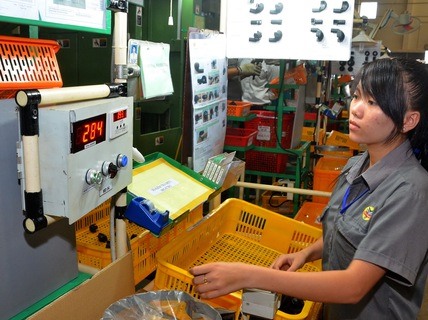 Economy
Economy

The national index of industrial production (IIP) increased 7.9 per cent year-on-year in the first nine months of this year, the General Statistics Office (GSO) reported.
 |
| The national index of industrial production (IIP) increased 7.9 per cent year-on-year in the first nine months of this year, the General Statistics Office (GSO) reported.— Photo vietnambiz.vn |
HÀ NỘI — The national index of industrial production (IIP) increased 7.9 per cent year-on-year in the first nine months of this year, the General Statistics Office (GSO) reported.
The metric was higher than the 7.1 per cent growth recorded in the first nine months last year, and 7.2 per cent in the first eight months of this year, GSO said.
While the first quarter IIP growth was 3.9 per cent, it surged to 8.1 per cent in the second quarter. The office estimates third quarter growth at 9.7 per cent.
The GSO attributed this year’s IIP growth to the breakthroughs in the processing and manufacturing sector, which made big strides with a rise of 12.8 per cent, contributing 9 percentage points to the overall IPP. This helped offset the strong drop of 8.1 per cent in mining, which reduced 1.8 percentage points from the nine-month figure.
Many industries enjoyed significant growth including electronics, computer and optical products (25.1 per cent), prefabricated metal products (14.2 per cent), metal production (21.4 per cent) and rubber and plastic products (11.6 per cent).
Among key industrial products that posted high IIP increases in nine months were television sets (31.6 per cent), raw steel and iron (28 per cent), urea (15.9 per cent), fabric (16.8 per cent) and processed seafood (9.4 per cent).
However, some other sectors saw lower growth rates, such as food processing (6.6 per cent), cloth (6.3 per cent), beverage (5 per cent) and coal and lignite exploitation (2 per cent).
Some sectors recorded industrial production declines. Medicine, pharmaceutical chemicals and pharmaceutical material production went down by 1.7 per cent, tobacco by 2 per cent and crude oil and natural gas by 10.7 per cent.
Locales where the IIP registered high growth were HCM City at 7.8 per cent; Cần Thơ at 6.9 per cent; Bình Dương at 9.5 per cent; Đồng Nai at 8.3 per cent and Đà Nẵng at 8.9 per cent; besides Bắc Ninh at 25.1 per cent; Hải Phòng at 20.1 per cent and Hà Nội at 6.7 per cent.
According to the GSO, the consumption index of the processing and manufacturing industry rose 9.9 per cent year-on-year, higher than the growth of 9 per cent year-on-year in the first eight months of 2016, contributing to the production growth in this industry.
The GSO said that to continue growth in industrial production, the industrial sector should reduce inventory because the inventory index of the sector in the first eight months witnessed a year-on-year surge of 10 per cent, 0.01 per cent higher than the growth recored in the first seven months. — VNS
PMI rises in SeptemberIn September, the Việt Nam Manufacturing Purchasing Managers’ Index (PMI) rose, with faster rises in output, new orders and employment on the back of stronger customer demand. This was revealed on Monday by the latest survey from Nikkei’s IHS Markit. The composite indicator of manufacturing performance stood at 53.3 in September, up from 51.8 in August. The reading signalled a solid monthly strengthening of business conditions, with the rate of improvement the most marked since April. The health of the sector has now strengthened in 22 consecutive months. “The anecdotal evidence has highlighted an improvement in customer demand over the month. This resulted in a sharp and accelerated increase in new business, the most marked in five months. The rate of expansion in new export orders also quickened in September,” the Nikkei’s IHS Markit reported. The manufacturing output increased for the 11th successive month, with the latest rise the most marked since April. All three broad sectors saw a production increase, led by consumer goods firms. Higher new orders contributed to capacity pressures, as signalled by a further rise in backlogs of work. Some panellists also mentioned that staff shortages contributed to the build-up of outstanding business. Firms responded to greater workloads by increasing their staffing levels. Moreover, the rate of job creation quickened to a six-month high, according to the report. Manufacturers also used inventories to help fulfill new orders in September. As a result, the stocks of finished goods decreased for the third month running, and to the greatest extent since July 2016. |




